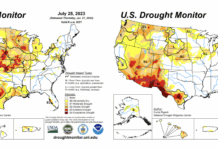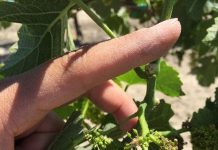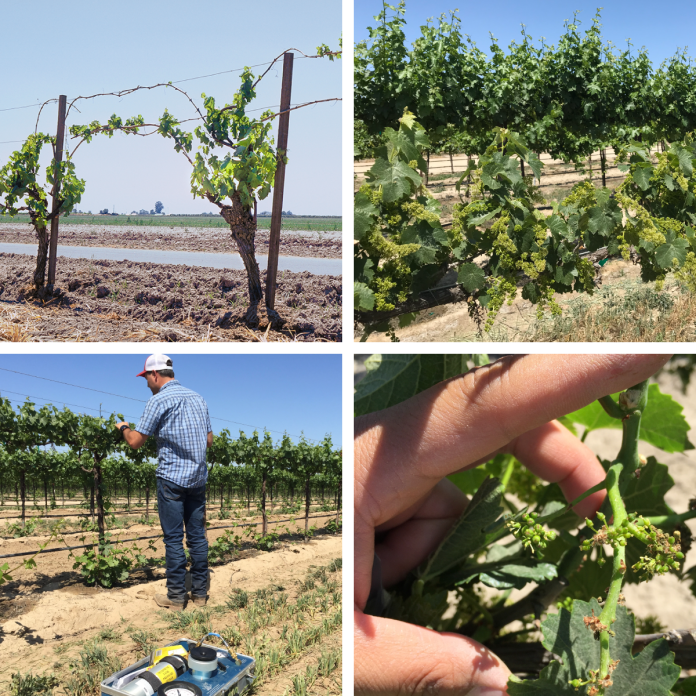
This past winter was a dry year with a total of <8.5 inches of precipitation (November 2020 to March 2021) and that was significantly lower than the historical average of 11 inches for the San Joaquin Valley (SJV). Winter drought and freeze temperatures last November and December (minimal temperature was as low as 20 degrees F) caused some severe damages on grapevines, and the delayed spring growth (DSG) was mostly reported by growers. DSG includes erratic bud break, stunted shoot development, dead shoot tips and excessive berry abscission with suckers pushing vigorously at the base of the vine. Some DSG symptoms were very similar to the symptoms of drought or grapevine water stress. Generally, most DSG vines recover after an irrigation event starts; however, the impact of DSG on yield might persist (poor fruit set and small bunch size), and growers likely suffer from the economic loss.
In the face of upcoming drought challenges, growers need to focus on three main areas to improve irrigation efficiency and maximize yield and quality: soil, grapevine canopy and weather condition.
Soil
Most grape roots are in the top three feet of soil, and this is the main area where our irrigation works. Due to the lack of winter precipitation, dormant or early season irrigation is necessary to restore the soil moisture, which supports grapevine budbreak as well as early season shoot elongation. Given that the severe drought condition persists in most of SJV, growers need to assess the soil dryness and moisture content at individual sites, since different soil types can hold moisture quite differently (Table 1). Sandier soil holds water poorly in comparison to clay soil. Conversely, water percolates more rapidly in sandy soil than clay soil. Therefore, with the same amount of precipitation or irrigation, clay soil can hold more than sandy soil and grapevine/cover crop can deplete the soil moisture much faster at sandier sites. Soil type can be accessed through UC Davis SoilWeb (casoilresource.lawr.ucdavis.edu/gmap/), or can be analyzed through commercial laboratories by collecting representative soil samples at a site. Cover crop and middle row vegetation should be mowed earlier under drought conditions to preserve soil moisture.
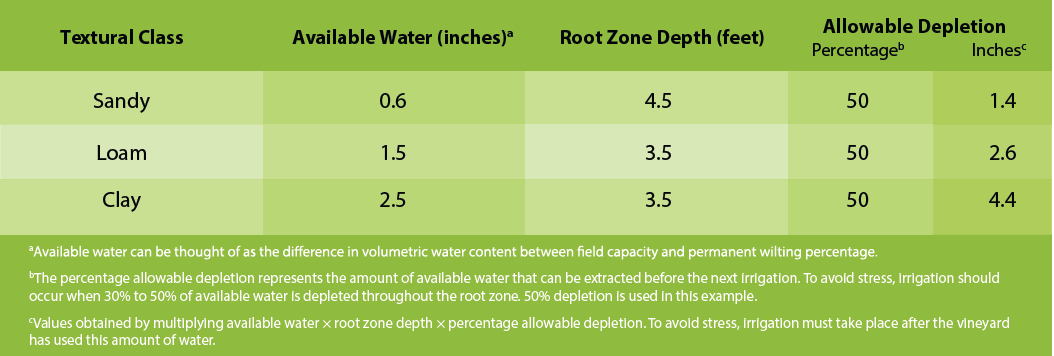
After understanding the different soil types and their water-holding characteristics, growers need to make the decision for first irrigation based on the soil moisture content, and that can be quite important during the current drought condition. Numerous tools are available for growers to use to measure soil moisture content, the most commonly used method being ‘feel and appearance’, where growers use a shovel or auger to dig out soil samples at different depths and feel the moisture by squeezing the soil in their hand.
Currently, growers have access to many inexpensive soil moisture sensors which can help to measure soil moisture in real time. There are mainly two types of soil moisture sensors: one measures soil water tension (e.g., tensiometer or WaterMark™) and the other measures soil volumetric water content (e.g., Neutron probe and capacitance sensor). Soil-water tension tells you how hard it is for the grapevine roots to pull water from the soil particles, and the reading is typically negative with units of centibar. The more negative the reading, the harder it is for the grapevine roots to absorb water. Growers can set up the pre-determined value of soil-water tension (e.g., -30 centibar) at a certain soil depth {e.g., two feet). Once the soil-water tension reaches the value, the irrigation should start. The pre-determined soil-water tension is usually between -30 and -40 centibar in SJV, varying across different soil types. However, soil-water tension does not tell you how much water has been depleted or the available water content. Soil volumetric water content, on the other hand, offers the percentage of water volume versus the total soil volume and tells you the amount of water stored in the soil and how much you need to irrigate to maintain the desired water content. Growers should irrigate the vineyard when 30% to 50% of allowable water is depleted throughout the root zone (Table 1). The soil volumetric water content is also well correlated to plant water stress measured by midday leaf water potential, and growers can potentially use soil volumetric water content to assess grapevine water stress (Figure 1).
Overall, growers can use both soil-water tension and soil volumetric water content mentioned above to monitor the soil moisture either indirectly or directly and schedule irrigation.
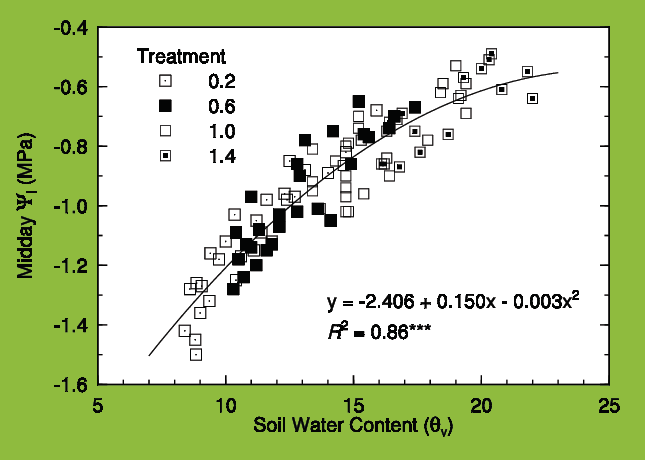
Grapevine Canopy
Grapevine canopy growth (e.g., budbreak and shoot elongation) depends on the availability of water and nutrients in the soil. Lack of soil moisture during the dormant season increases the risk of freeze damage and hinders the start of budbreak and early season shoot elongation, causing DSG. DSG usually occurs when the grapevine suffers water stress at the beginning of the growing season. If the drought condition persists, shoot elongation might be hampered, and the shoot tip might die off due to lack of water. Under severe drought stress, inflorescences will die off and cause significant yield loss.
To prevent early season vine water stress, soil moisture is the key measurement to decide when to irrigate as was previously mentioned. However, canopy appearance and visual assessment can help to confirm the success of an irrigation program. First, upward-growing shoot tips and tendrils are the most obvious signs of a healthy canopy. Second, a pressure chamber to measure midday leaf water potential might offer a powerful tool to validate the irrigation program (Table 2).

Grapevine water demand is directly related to the amount of sunlight captured by the canopy, and a larger canopy needs more water than a smaller canopy due to receiving more light. Therefore, as the shoot grows and the canopy expands, grapevines generally use more water. Most grapevine irrigation recommendations are based on the canopy size and climatic condition. Canopy management (e.g., leafing, shoot tucking/thinning and hedging) has the potential to influence the canopy size and amount of light received, and ultimately water use.

Grapevines at different growth stages have different sensitivity and tolerance to water stress. From budbreak to bloom, the grapevine is very sensitive to water stress, and even a mild stress will hinder growth and cause irreversible yield loss. Generally, water stored in the soil profile after winter precipitation is enough to support vine growth. However, in years of drought such as this year, soil moisture may be inadequate to support growth, and irrigation is needed to replenish soil moisture. From bloom to fruit set, the grapevine is also sensitive to water stress, and severe stress causes poor set and yield loss. Fruit set to veraison is a good time to apply some stress if growers are looking to reduce berry size (e.g., smaller berry) and improve berry quality (e.g., color). However, the benefit of improved berry quality might come with the sacrifice of yield. Typically, in SJV, mild stress is recommended at this period to balance quality and yield. From veraison to harvest may be the best time to apply some stress to advance berry ripening and reduce disease pressure (e.g., bunch rot). However, growers need to avoid severe stress which results in excessive defoliation, since a healthy canopy is required for photosynthesis. Postharvest, it is generally recommended to replenish the soil profile, since the photosynthetic active canopy still produces the carbon to refill the reserve of trunk and roots, and the reserve will be used to support the vine growth of the following season. Postharvest irrigation in abundant quantities can also help to leach the salts and alleviate the concern of salinity.
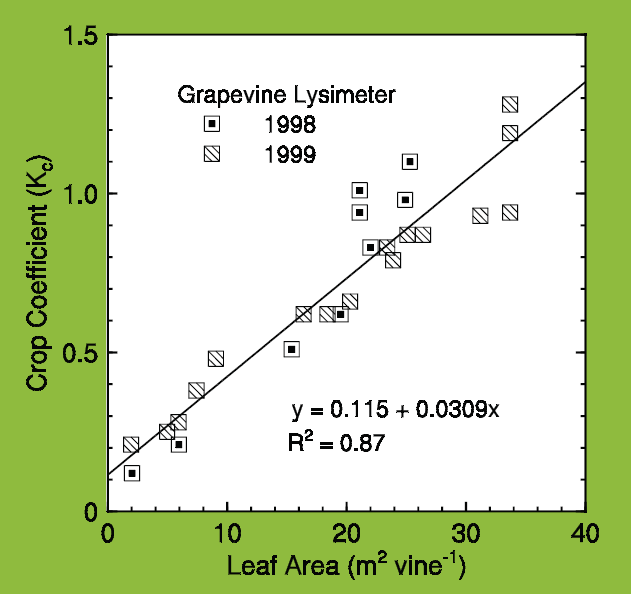
Weather Conditions
As was previously mentioned, grapevine water use depends on two main factors: canopy size and weather. Most growers know crop evapotranspiration (ET) and can calculate grapevine water demand over a given period through the calculation: grapevine evapotranspiration (ETc) = reference evapotranspiration (ETo) × crop coefficient (Kc). Growers can simply use ETc to irrigate the grapevines weekly by using gallons/vine/week or hours/vine/week after factoring in the application rate. Kc is related to canopy size (Figure 2, see page 38) and ETo is related to weather condition (Figure 3). ETo is strongly correlated with sunlight and the ambient temperature. A sunny and cloudless day will drive more grapevine water use than a cloudy and foggy day or a smokey day as occurred last year due to the wildfires. Similarly, a forecasted heat wave will cause severe water stress if there is lack of irrigation. Water stress coupled with temperatures >100 degrees F disrupts berry growth and sugar accumulation and causes yield loss and maturation delay.

Currently, there are different ways growers can adjust irrigation based on weather condition: 1) National Weather Service (digital.weather.gov/) provides the weather forecast as well as forecasted ETo. Growers can adjust the irrigation amount based on forecasted weather and ET. 2) UCCE is launching weekly crop ET reports (ucanr.edu/sites/viticulture-fresno/Irrigation_Scheduling/), so growers do not need to calculate weekly grapevine ET or gallons/vine/week themselves. Irrigation can be simply followed on the ET reports.
Finally, growers need to put economic consideration into water management. Water might be better used for younger blocks than a vineyard which is near the end of its lifespan, and it also makes more economic sense to use water for the cultivar which has a better price when the water is scarce. The take-home message on vineyard water management is:
- Check soil moisture at all levels.
- Assess canopy, vine water status and weather condition.
- Spend water when it is needed the most.
- Salinity becomes an important factor in determining water management.
- Mow cover crop or middle row vegetation early to preserve soil moisture.

References
Williams, L. and Trout, T. 2005. Relationships among Vine- and Soil-Based Measures of Water Status in a Thompson Seedless Vineyard in Response to High-Frequency Drip Irrigation. Am J Enol Vitic. 56: 357-366.
L. P. Christensen. 2000. Raisin Production Manual. University of California Agriculture and Natural Resources Publication 3393.












